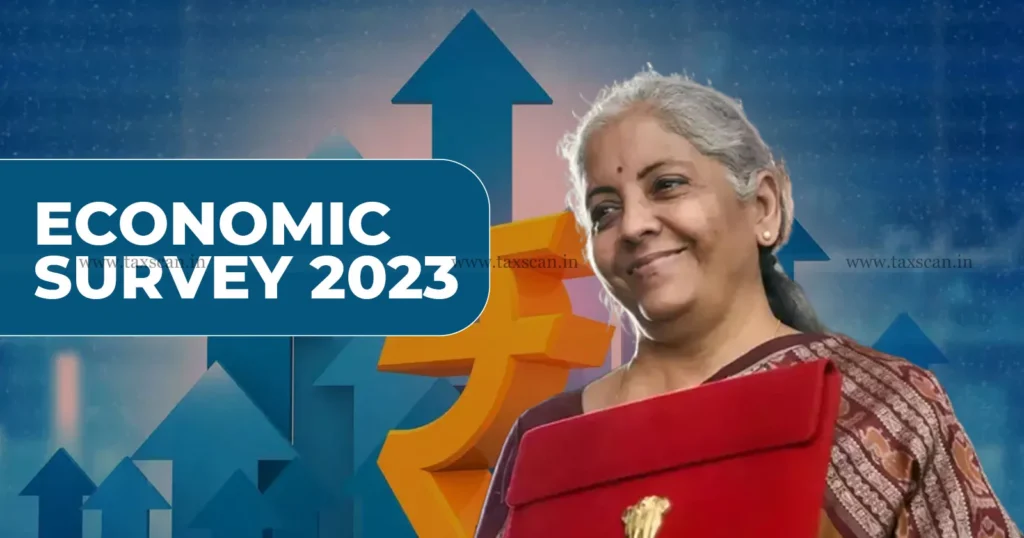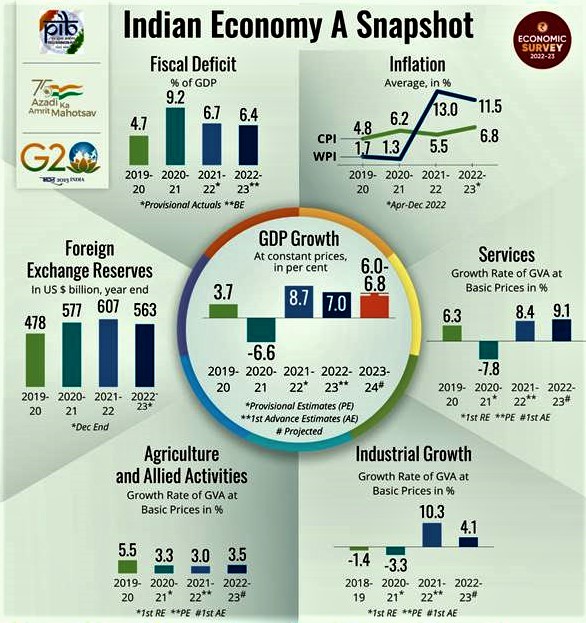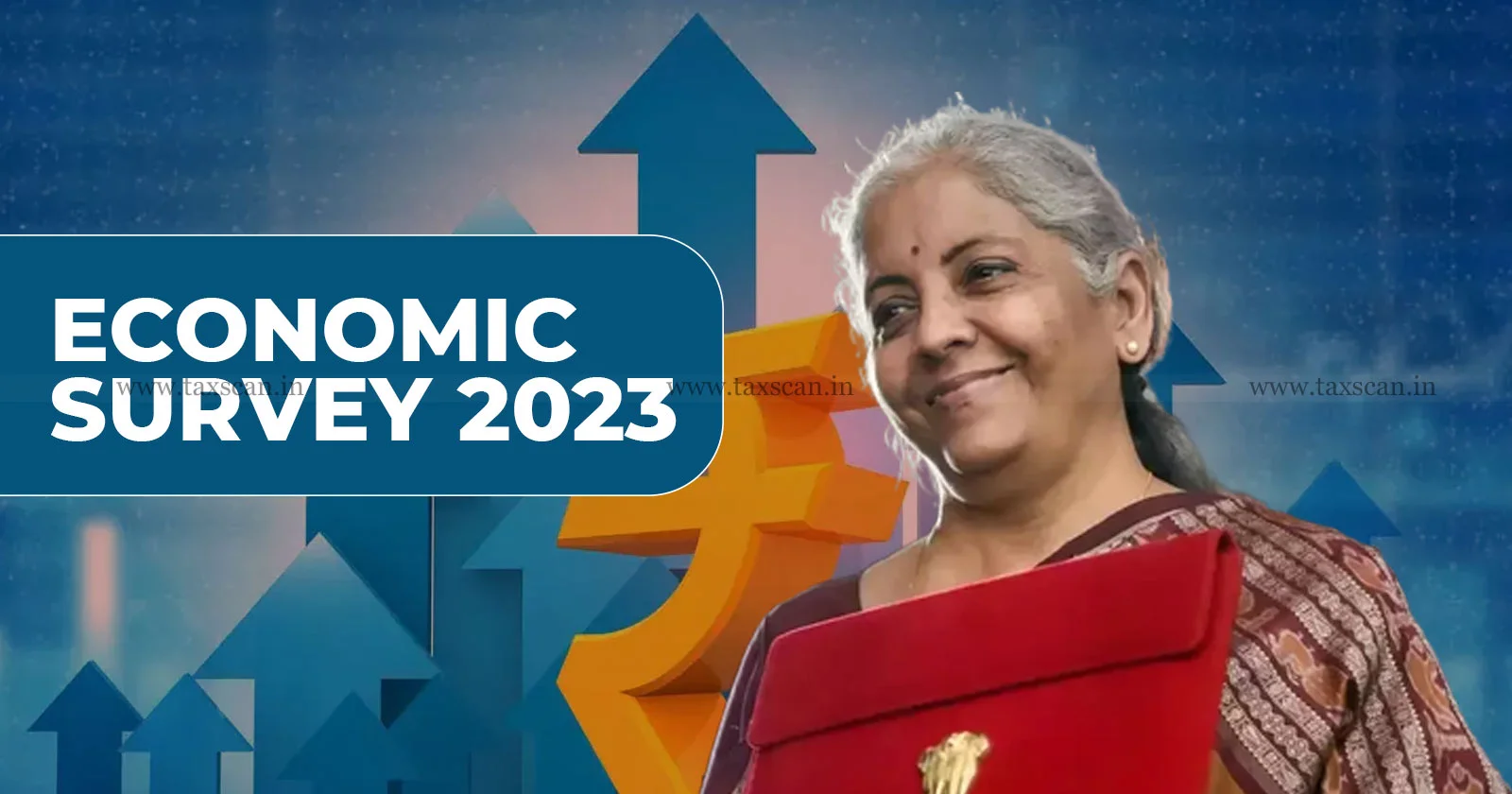
The Economic Survey 2022-23 prepared by a team of economists led by chief economic adviser Anantha Nageswaran analyses developments in the economy in the past year and makes projections for the following year.

Growth
- India is the 3rd largest economy in the world in PPP terms and the 5th largest in market exchange rates.
- GDP – The Indian economy is expected to expand 7% in real terms in 2022-23.
- It has been projected to be around 6.0 to 6.8% in 2023-24 depending on the trajectory of economic and political developments globally.
- Global growth is forecasted to slow to 2.7% in 2023 as per IMF’s World Economic Outlook, October 2022.
- Private consumption – As a percentage of GDP, private consumption recovered to 58.4% in the second quarter of 2022-23, due to rebound in contact-intensive services such as trade and transport.
Fiscal developments
- Inflation – India’s retail inflation rate peaked at 7.8% in April 2022, above the Reserve Bank of India’s (RBI) upper tolerance limit of 6%.
- Tax collection – The gross tax revenue registered a year-on-year growth of 15.5% from April to November 2022 driven by robust growth in the direct taxes and GST.
- Capital expenditure – The Centre’s capital expenditure rose to 2.5% of GDP in 2021-22.
Monetary management
- Non-performing assets – The gross non-performing assets ratio of scheduled commercial banks fell to a seven-year low of 5%.
- CRAR – The Capital-to-Risk Weighted Assets Ratio (CRAR) remains healthy at 16.0.
- Fiscal deficit – The survey expressed confidence that the Union government should be able to meet the fiscal deficit target of 6.4% of GDP for this financial year.
- The government aims to lower the fiscal deficit to 4.5% of GDP by FY26 from a target of 6.4% of GDP in this fiscal year.
Social infrastructure and employment
- Education – As a share of total GDP, the budgetary allocation for education was at 2.9%.
- Health – The out-of-pocket expenditure as a percentage of total health expenditure declined to 48.2 % in 2018-19.
- Food security – Schemes like PM-Kisan and PM Garib Kalyan Yojana have helped in ensuring food security and their impact was also endorsed by the United Nations Development Programme (UNDP).
- Inclusion – The JAM (Jan-Dhan, Aadhaar and mobile) trinity and direct benefit transfers has brought the marginalised sections into the formal financial system.
- Employment – Labour markets recovered beyond pre-Covid levels, in both urban and rural areas, with unemployment rates falling to 4.2% in 2020-21.
- Mahatma Gandhi National Rural Employment Guarantee Scheme (MGNREGS) is indirectly creating opportunities for rural households to diversify their sources of income generation.
Agriculture and food management
- Private investment – Private investment in agriculture rose to 9.3% in 2020-21.
- Institutional credit – Institutional credit to the agricultural sector continued to grow to Rs 18.6 lakh crore in 2021-22.
- MSP – The minimum support price for all mandated crops was fixed at 1.5 times of the all-India weighted average cost of production from 2018.
- Foodgrain production – Foodgrain production in India saw sustained increase and stood at 315.7 million tonnes in 2021-22.
- India stands at the forefront to promote millets through the International Year of Millets initiative.
Industry
- India became the second-largest mobile phone manufacturer globally.
- The production-linked incentive (PLI) schemes were introduced across 14 categories, with an estimated capex of Rs 4 lakh crore over the next five years, to plug India into global supply chains.
Services
- The services sector is expected to grow at 9.1% in 2022-23.
- India was among the top ten services exporting countries in 2021.
- India’s e-commerce market is projected to grow at 18% annually through 2025.
External sector
- Exports – Merchandise exports were 332.8 billion dollars for April-December 2022 as India diversified its markets to Brazil, South Africa and Saudi Arabia.
- India entered into a comprehensive economic partnership agreement with the United Arab Emirates and an economic cooperation and trade agreement with Australia in 2022.
- Remittances – India continued to be the largest recipient of remittances in the world, netting 100 billion dollar in 2022.
- Remittances are the 2nd largest major source of external financing after service exports.
- Forex reserves – As of end-November 2022, India was the 6th largest foreign exchange reserves holder in the world.
Climate Change and Environment
- India declared the Net Zero Pledge to achieve net zero emissions goal by 2070.
- India achieved its target of 40% installed electric capacity from non-fossil fuels ahead of 2030.
- A mass movement LIFE– Life style for Environment was launched.
- Sovereign Green Bond Framework (SGrBs) were issued in 2022.
- National Green Hydrogen Mission enables India to be energy independent by 2047.
Infrastructure
- Physical Infrastructure- Projects that are currently active include
- National Infrastructure Pipeline
- National Monetisation Pipeline
- Gati Shakti
- National Logistics Policy
- Digital Public Infrastructure
- Unified Payment Interface (UPI)-based transactions grew in value (121%) and volume (115%) terms between 2019-22.
- Rural internet subscriptions witnessed a 200% increase, between 2015 and 2021.
Challenges for the Global Economy
- The Survey narrates about six challenges faced by the global economy.
- COVID-19 related disruptions in economies
- Russian-Ukraine conflict and its adverse impact along with disruption in supply chain
- Central Banks led by Federal Reserve responding with policy rate hikes to curb inflation, leading to appreciation of US Dollar and widening of Current Account Deficits (CAD) in net importing economies
- The prospects of global stagflation compelling the nations to protect their respective economic space, thus slowing cross-border trade
- China’s slowdown induced by its policies
- Loss of education and income-earning opportunities brought in by the pandemic




